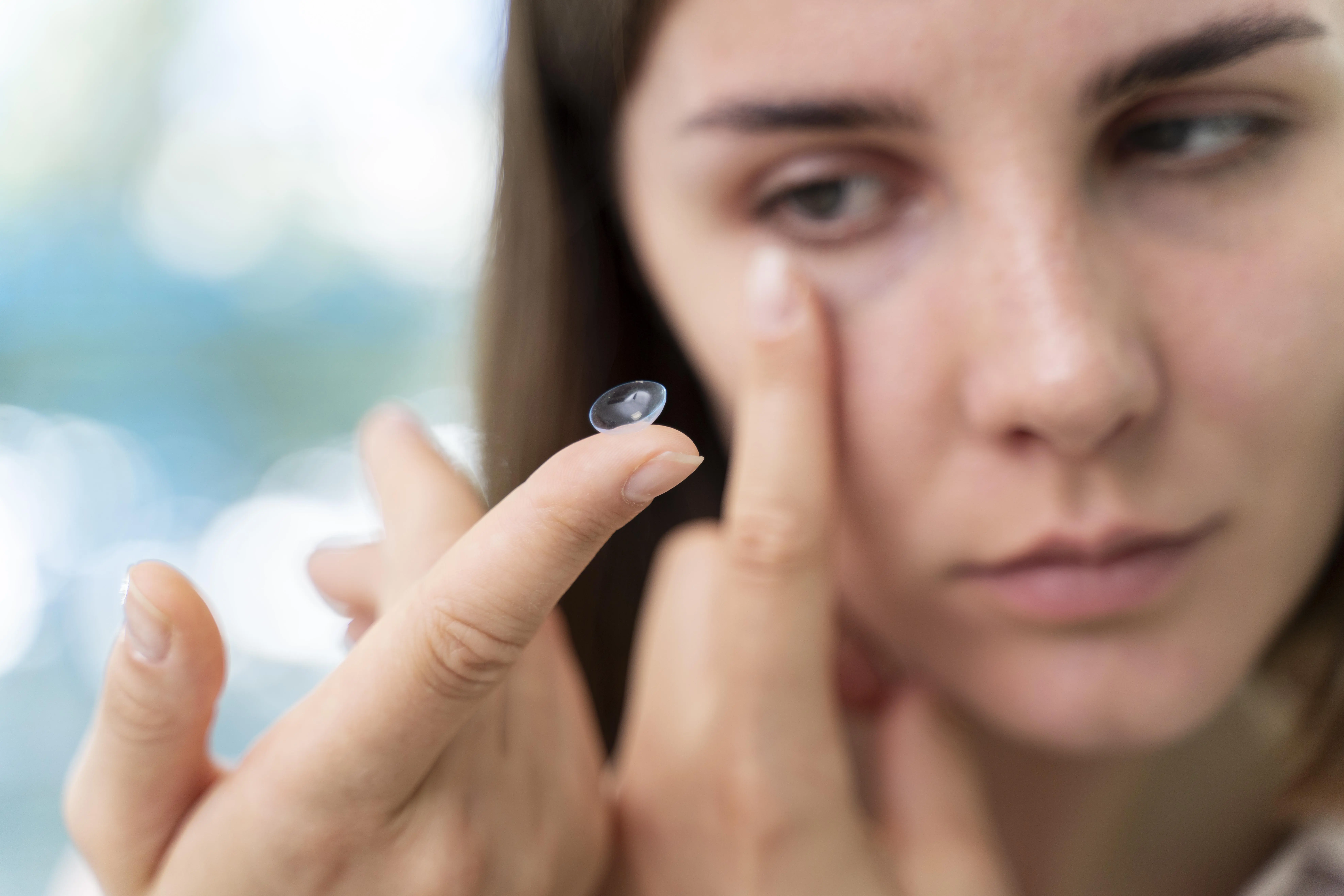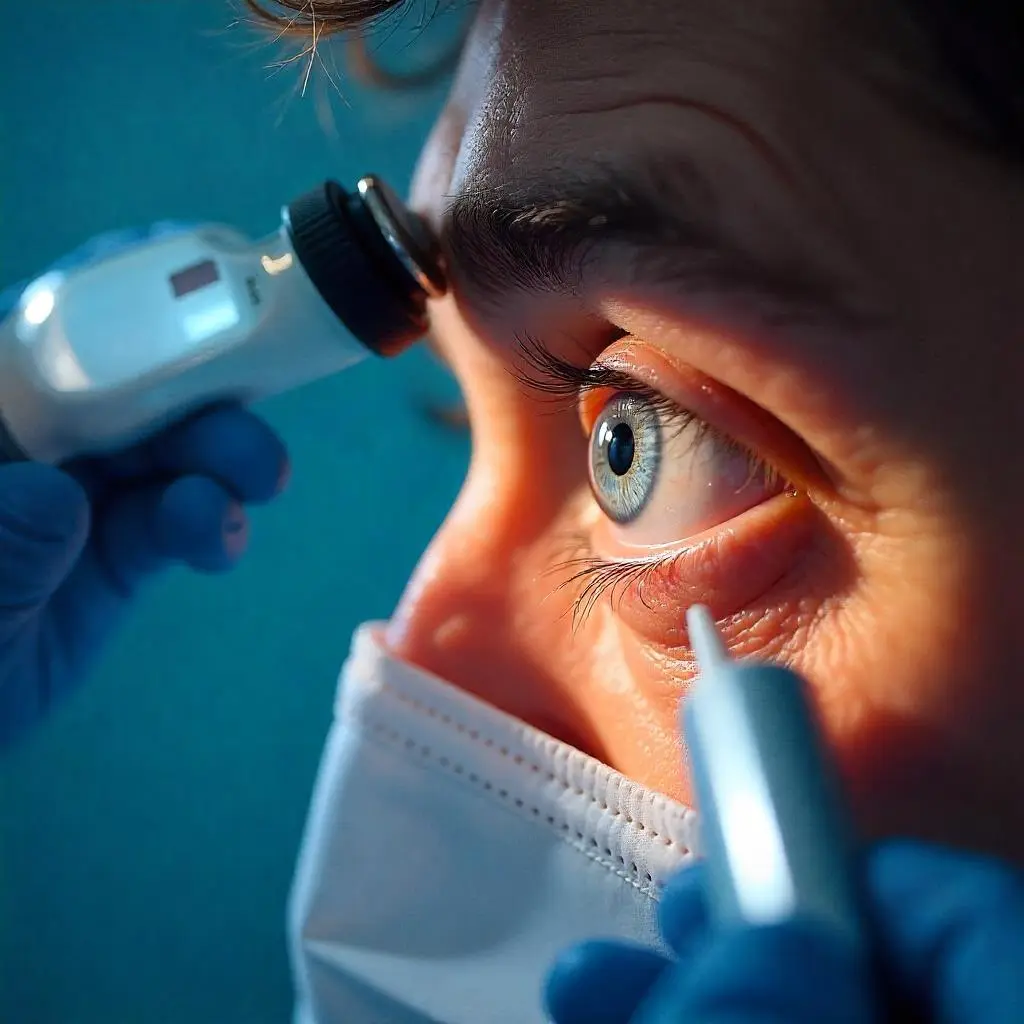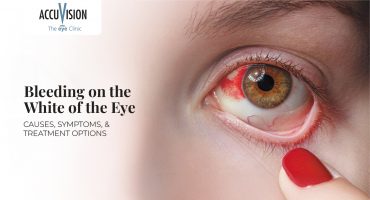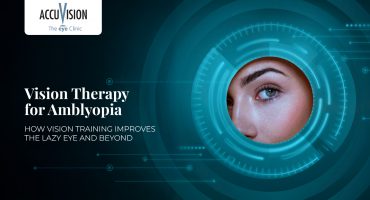- What is Keratoconus?
- Symptoms of Keratoconus
- Causes & Risk Factors
- Diagnosis
- Keratoconus Treatment Options
- Keratoconus Self-Care & Prevention Tips
- Why Choose AccuVision for Keratoconus Treatment?
- Keratoconus Treatment in Young Adults and Children
Keratoconus is an eye condition that can significantly impact your vision and quality of life if left untreated. Though it is not uncommon, advancements in diagnostics and treatment now offer effective options for managing the condition and preserving vision.
In this guide, we explain what keratoconus is, explore the symptoms, causes, and the best available keratoconus treatment options, including corneal cross linking, so you can make informed decisions about your eye health.
What is Keratoconus?
Keratoconus is a progressive eye disorder that causes the cornea (the clear, dome-shaped front surface of the eye) to thin and gradually bulge outward into a cone shape. This irregular shape distorts vision and can lead to increasing levels of astigmatism and short sightedness.
Unlike conditions that can be corrected with standard glasses, keratoconus affects the structural integrity of the cornea, making vision correction more complex over time.
Symptoms of Keratoconus
Symptoms typically begin in adolescence or early adulthood and can worsen over time. Common signs include:
- Blurred or distorted vision
- Increased sensitivity to light and glare
- Eye strain and headaches
- Frequent changes in glasses or contact lens prescriptions
- Difficulty seeing at night
- Ghosting or halos around lights
As the condition progresses, vision may deteriorate to the point where standard glasses or contact lenses no longer provide adequate correction.
Causes & Risk Factors
The exact causes of corneal thinning associated with keratoconus remain unclear, but several risk factors are known to contribute:
- Genetics: A family history of keratoconus increases the likelihood of developing the condition.
- Chronic eye rubbing: Often linked to allergies or conditions like eczema, frequent eye rubbing can damage corneal tissue over time.
- Underlying conditions: Conditions such as Down syndrome, Marfan syndrome, and certain connective tissue disorders are associated with higher risk.
- Environmental factors: Oxidative stress and UV exposure may contribute to corneal degradation.
Diagnosis
Early detection is critical. Diagnosis typically involves:
- Corneal topography: A detailed map of the cornea’s curvature, revealing thinning or bulging areas.
- Pachymetry: Measures corneal thickness.
- Slit-lamp examination: A magnified inspection of the eye’s surface and cornea.
Many patients with keratoconus are not diagnosed in the early stages through routine high street eye exams. These standard exams often miss the condition until it is more advanced.
If you notice large or frequent prescription changes within a year, increasing astigmatism, reduced quality of night vision, or have a family history of keratoconus, you should seek a specialised eye health assessment. These detailed tests can detect early signs of keratoconus before it significantly affects your vision.
Keratoconus Treatment Options
Fortunately, there are several modern and effective options available for keratoconus treatment, depending on the severity of the condition.
1. Glasses and Soft Contact Lenses

In the early stages, vision distortion can often be managed with prescription glasses or soft contact lenses. However, as the disease progresses, these may become less effective.
2. Specialised Contact Lenses
Rigid gas permeable (RGP) or scleral lenses are commonly prescribed for moderate keratoconus. These lenses vault over the irregular cornea to create a smooth surface for improved vision.
3. Corneal Collagen Cross Linking (CXL)

Corneal cross linking is now considered the standard of care for preserving vision and maintaining corneal integrity in keratoconus. This minimally invasive procedure uses ultraviolet (UV) light and riboflavin drops to strengthen the corneal structure. CXL helps halt the progression of keratoconus, reducing the likelihood of needing a corneal transplant.
In addition, more advanced treatment options may be considered based on your individual case:
- Custom PRK and T-CAT (Topography-Guided Custom Ablation Treatment): These advanced laser procedures aim to regularise the corneal surface and improve visual quality.
- ICL (Implantable Collamer Lens) Surgery: For patients not suitable for laser procedures, ICL (Implantable Collamer Lens) offers an effective surgical option to correct vision by implanting a lens inside the eye.
Specialised contact lenses and glasses may still be used alongside treatments to support daily vision needs, but these do not treat the underlying condition.
Known as corneal collagen cross linking, this procedure increases corneal rigidity and stability, reducing the risk of further bulging.
Benefits of cross-linking eye surgery include:
- Slowing or halting keratoconus progression
- Preventing the need for corneal transplant in many cases
- Safe and effective in both teens and adults
At AccuVision, we use the latest accelerated corneal cross linking surgery technology for better patient comfort and quicker recovery.
4. Intracorneal Ring Segments (ICRS)
These are tiny, curved devices surgically implanted into the cornea to flatten it and improve its shape. This method can improve vision but is typically considered when contact lenses are no longer effective.
5. Corneal Transplant
In advanced cases where scarring or extreme thinning occurs, a corneal transplant may be necessary. However, thanks to earlier intervention options like cornea collagen cross linking, this is becoming less common.
Over the years, the AccuVision team has helped pioneer several of the advanced cross-linking techniques now widely used in complex keratoconus cases. By working closely with our innovative technology partners, we continue to deliver improved corneal profiles and enhanced visual quality, even for patients who have not found success with other treatment centres.
Keratoconus Self-Care & Prevention Tips
While there may be no definitive cure for keratoconus, certain practices can help manage its progression:
- Avoid eye rubbing: Important if you suffer from allergies or itchy eyes
- Treat underlying allergies: Use prescribed antihistamines or eye drops
- Protect eyes from UV exposure: Wear sunglasses outdoors
- Follow your treatment plan: Important if undergoing corneal cross linking
- Attend regular follow-ups: To monitor corneal stability and detect changes early
These keratoconus self-care strategies are essential for long-term eye health and visual stability.
Why Choose AccuVision for Keratoconus Treatment?
AccuVision is a trusted leader in advanced keratoconus treatment, combining clinical expertise with the latest in diagnostic and surgical technology.
Here’s why patients choose us:
- Early detection through advanced diagnostics
- Specialists in customised keratoconus cross linking treatments
- Expertise in managing complex and progressive cases
- Access to Non-invasive management and minimally invasive surgical options, including keratoconus laser eye surgery alternatives
- Transparent consultations and long-term care plans tailored to each patient
Our team of highly experienced clinicians and surgeons work closely with each patient to ensure they receive the most appropriate treatment at the right stage of the condition.
Keratoconus Treatment in Young Adults and Children
AccuVision has held specialist status for many years, allowing us to treat young adults and children aged 12 years and above with keratoconus. Early diagnosis and timely cross linking in this age group are critical to halting disease progression and preserving vision. Our expert clinicians use age-appropriate diagnostics and treatment protocols designed specifically for younger corneas, offering families peace of mind and better long-term outcomes.
Conclusion
While keratoconus can be a challenging diagnosis, modern treatments, especially corneal cross linking, offer highly effective ways to manage and stabilise the condition before it affects long-term vision.
Whether you’ve just been diagnosed or are exploring more advanced keratoconus surgery options, AccuVision is here to help you see the future clearly.
Struggling with Keratoconus? Get Expert Care at AccuVision.
Schedule Your Consultation Today!
Frequently asked questions:
Can I live a normal life with keratoconus?
Yes, with proper diagnosis and treatment, like contact lenses or cross linking, most people with keratoconus can maintain good vision and lead a normal life.
Can glasses fix keratoconus?
Glasses can help in the early stages but may become ineffective as the cornea becomes more irregular. Advanced stages often require specialised lenses or treatment.
How much does keratoconus surgery cost?
Costs vary depending on the procedure and individual needs. A consultation is the best way to determine the most appropriate and cost-effective option.
What is the best treatment for keratoconus?
Corneal cross linking is currently the most effective way to stop progression. Advanced cases may need specialised lenses, ring segments, or surgery.








